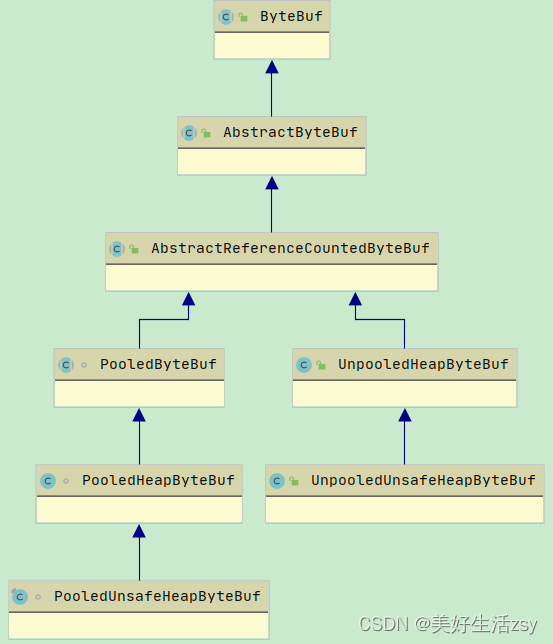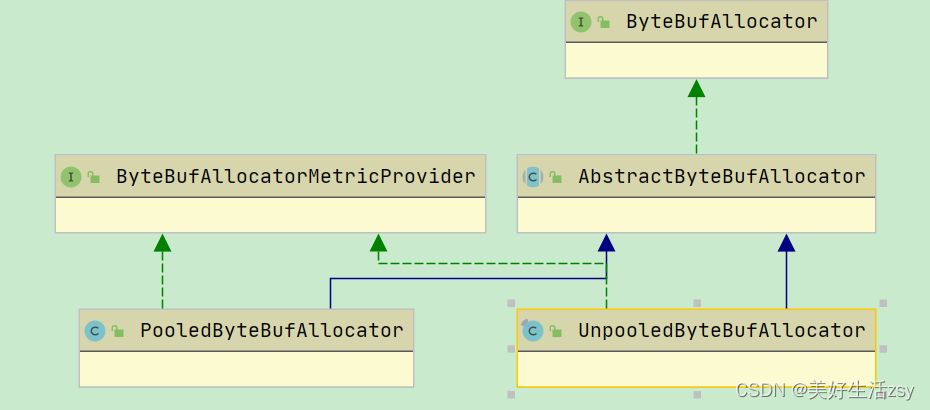ByteBuffer结构
在ByteBuffer中有三个区域,可丢弃部分,可读部分,可写部分。分别对应了三个指针,readerIndex,writerIndex,capacity,进行读写时,可根据这几个指针的位置进行读写。

读,写,mark,reset方法
在进行数据的读取时通过readerIndex位置开始读取一个字节
public byte readByte() {
checkReadableBytes0(1);
int i = readerIndex;
byte b = _getByte(i);
readerIndex = i + 1;
return b;
}
在进行写数据时从writerIndex位置开始写入数据
public ByteBuf writeByte(int value) {
ensureWritable0(1);
_setByte(writerIndex++, value);
return this;
}
mark方法给当前指针做标记
@Override
public ByteBuf markReaderIndex() {
markedReaderIndex = readerIndex;
return this;
}
reset方法,重置标记处的指针
public ByteBuf resetReaderIndex() {
readerIndex(markedReaderIndex);
return this;
}
ByteBuffer分类

在AbstractByteBuf中包含了 readerIndex; writerIndex; markedReaderIndex; markedWriterIndex; maxCapacity;几个读写相关的指针。
通过ByteBuffer结构,可判断可读,可写区域的字节数。
@Override
public int readableBytes() {
return writerIndex - readerIndex;
}
@Override
public int writableBytes() {
return capacity() - writerIndex;
}
@Override
public int maxWritableBytes() {
return maxCapacity() - writerIndex;
}
Pooled和UnPooled
Pooled和UnPooled的区别在于获取内存时有没有通过缓存池。
内存分配器ByteBufAllocator
在Netty中有两种内存分配器,一种是PooledByteBufAAllocator,一种是UnpooledByteBufAllocator。

UnpooledByteBufAllocator
在newHeapBuffer中最终会调到UnpooledHeapByteBuf的构造函数进行创建一个初始容量大小的Byte数组
protected ByteBuf newHeapBuffer(int initialCapacity, int maxCapacity) {
return PlatformDependent.hasUnsafe() ?
new InstrumentedUnpooledUnsafeHeapByteBuf(this, initialCapacity, maxCapacity) :
new InstrumentedUnpooledHeapByteBuf(this, initialCapacity, maxCapacity);
}
public UnpooledHeapByteBuf(ByteBufAllocator alloc, int initialCapacity, int maxCapacity) {
super(maxCapacity);
if (initialCapacity > maxCapacity) {
throw new IllegalArgumentException(String.format(
"initialCapacity(%d) > maxCapacity(%d)", initialCapacity, maxCapacity));
}
this.alloc = checkNotNull(alloc, "alloc");
setArray(allocateArray(initialCapacity));
setIndex(0, 0);
}
在堆外内存的分配逻辑中,最终会调到UnpooledDirectByteBuf的构造函数中通过
ByteBuffer.allocateDirect(initialCapacity)申请一个初始大小的内存。
protected ByteBuf newDirectBuffer(int initialCapacity, int maxCapacity) {
final ByteBuf buf;
if (PlatformDependent.hasUnsafe()) {
buf = noCleaner ? new InstrumentedUnpooledUnsafeNoCleanerDirectByteBuf(this, initialCapacity, maxCapacity) :
new InstrumentedUnpooledUnsafeDirectByteBuf(this, initialCapacity, maxCapacity);
} else {
buf = new InstrumentedUnpooledDirectByteBuf(this, initialCapacity, maxCapacity);
}
return disableLeakDetector ? buf : toLeakAwareBuffer(buf);
}
public UnpooledDirectByteBuf(ByteBufAllocator alloc, int initialCapacity, int maxCapacity) {
super(maxCapacity);
ObjectUtil.checkNotNull(alloc, "alloc");
checkPositiveOrZero(initialCapacity, "initialCapacity");
checkPositiveOrZero(maxCapacity, "maxCapacity");
if (initialCapacity > maxCapacity) {
throw new IllegalArgumentException(String.format(
"initialCapacity(%d) > maxCapacity(%d)", initialCapacity, maxCapacity));
}
this.alloc = alloc;
setByteBuffer(allocateDirect(initialCapacity), false);
}
PooledBytebufAllocator
在newDirectBuffer的流程处理如下:
1. 通过threadCache中获取一个PoolThreadCache,threadCache是一个ThreadLocal变量
2. 通过PoolThreadCache中获取PoolArena对象
3.通过PoolArena对象申请内存
protected ByteBuf newDirectBuffer(int initialCapacity, int maxCapacity) {
PoolThreadCache cache = threadCache.get();
PoolArena<ByteBuffer> directArena = cache.directArena;
final ByteBuf buf;
if (directArena != null) {
buf = directArena.allocate(cache, initialCapacity, maxCapacity);
} else {
buf = PlatformDependent.hasUnsafe() ?
UnsafeByteBufUtil.newUnsafeDirectByteBuf(this, initialCapacity, maxCapacity) :
new UnpooledDirectByteBuf(this, initialCapacity, maxCapacity);
}
return toLeakAwareBuffer(buf);
}
在directArea.allocate方法中通过带有RECYCLER回收池这样一个东西,进行的ByteBuf的循环利用,这就是Pool的池化.
static PooledUnsafeDirectByteBuf newInstance(int maxCapacity) {
PooledUnsafeDirectByteBuf buf = RECYCLER.get();
buf.reuse(maxCapacity);
return buf;
}
在PooledByteBufAllocator构造方法中,会创建heapArenas和directArenas
public PooledByteBufAllocator(boolean preferDirect, int nHeapArena, int nDirectArena, int pageSize, int maxOrder,
int smallCacheSize, int normalCacheSize,
boolean useCacheForAllThreads, int directMemoryCacheAlignment) {
super(preferDirect);
threadCache = new PoolThreadLocalCache(useCacheForAllThreads);
this.smallCacheSize = smallCacheSize;
this.normalCacheSize = normalCacheSize;
if (directMemoryCacheAlignment != 0) {
if (!PlatformDependent.hasAlignDirectByteBuffer()) {
throw new UnsupportedOperationException("Buffer alignment is not supported. " +
"Either Unsafe or ByteBuffer.alignSlice() must be available.");
}
// Ensure page size is a whole multiple of the alignment, or bump it to the next whole multiple.
pageSize = (int) PlatformDependent.align(pageSize, directMemoryCacheAlignment);
}
chunkSize = validateAndCalculateChunkSize(pageSize, maxOrder);
checkPositiveOrZero(nHeapArena, "nHeapArena");
checkPositiveOrZero(nDirectArena, "nDirectArena");
checkPositiveOrZero(directMemoryCacheAlignment, "directMemoryCacheAlignment");
if (directMemoryCacheAlignment > 0 && !isDirectMemoryCacheAlignmentSupported()) {
throw new IllegalArgumentException("directMemoryCacheAlignment is not supported");
}
if ((directMemoryCacheAlignment & -directMemoryCacheAlignment) != directMemoryCacheAlignment) {
throw new IllegalArgumentException("directMemoryCacheAlignment: "
+ directMemoryCacheAlignment + " (expected: power of two)");
}
int pageShifts = validateAndCalculatePageShifts(pageSize, directMemoryCacheAlignment);
if (nHeapArena > 0) {
heapArenas = newArenaArray(nHeapArena);
List<PoolArenaMetric> metrics = new ArrayList<PoolArenaMetric>(heapArenas.length);
for (int i = 0; i < heapArenas.length; i ++) {
PoolArena.HeapArena arena = new PoolArena.HeapArena(this,
pageSize, pageShifts, chunkSize,
directMemoryCacheAlignment);
heapArenas[i] = arena;
metrics.add(arena);
}
heapArenaMetrics = Collections.unmodifiableList(metrics);
} else {
heapArenas = null;
heapArenaMetrics = Collections.emptyList();
}
if (nDirectArena > 0) {
directArenas = newArenaArray(nDirectArena);
List<PoolArenaMetric> metrics = new ArrayList<PoolArenaMetric>(directArenas.length);
for (int i = 0; i < directArenas.length; i ++) {
PoolArena.DirectArena arena = new PoolArena.DirectArena(
this, pageSize, pageShifts, chunkSize, directMemoryCacheAlignment);
directArenas[i] = arena;
metrics.add(arena);
}
directArenaMetrics = Collections.unmodifiableList(metrics);
} else {
directArenas = null;
directArenaMetrics = Collections.emptyList();
}
metric = new PooledByteBufAllocatorMetric(this);
}
在PoolThreadCache的构造方法中进行按页或子页进行分配
PoolThreadCache(PoolArena<byte[]> heapArena, PoolArena<ByteBuffer> directArena,
int smallCacheSize, int normalCacheSize, int maxCachedBufferCapacity,
int freeSweepAllocationThreshold) {
checkPositiveOrZero(maxCachedBufferCapacity, "maxCachedBufferCapacity");
this.freeSweepAllocationThreshold = freeSweepAllocationThreshold;
this.heapArena = heapArena;
this.directArena = directArena;
if (directArena != null) {
smallSubPageDirectCaches = createSubPageCaches(
smallCacheSize, directArena.numSmallSubpagePools);
normalDirectCaches = createNormalCaches(
normalCacheSize, maxCachedBufferCapacity, directArena);
directArena.numThreadCaches.getAndIncrement();
} else {
// No directArea is configured so just null out all caches
smallSubPageDirectCaches = null;
normalDirectCaches = null;
}
if (heapArena != null) {
// Create the caches for the heap allocations
smallSubPageHeapCaches = createSubPageCaches(
smallCacheSize, heapArena.numSmallSubpagePools);
normalHeapCaches = createNormalCaches(
normalCacheSize, maxCachedBufferCapacity, heapArena);
heapArena.numThreadCaches.getAndIncrement();
} else {
// No heapArea is configured so just null out all caches
smallSubPageHeapCaches = null;
normalHeapCaches = null;
}
// Only check if there are caches in use.
if ((smallSubPageDirectCaches != null || normalDirectCaches != null
|| smallSubPageHeapCaches != null || normalHeapCaches != null)
&& freeSweepAllocationThreshold < 1) {
throw new IllegalArgumentException("freeSweepAllocationThreshold: "
+ freeSweepAllocationThreshold + " (expected: > 0)");
}
}
缓存数据结构
在MemoryRegionCache中有三部分组成,size,queue,sizeclass。
在queue中每个都是一个Entry,一个Entry中有一个chunk和一个handle(执行chunk的内存地址)
sizeClass是指tiny(0-512B),small(512B-4K),normal(8K-16M)
private abstract static class MemoryRegionCache<T> {
private final int size;
private final Queue<Entry<T>> queue;
private final SizeClass sizeClass;
private int allocations;
命中缓存的内存分配原则
1. 根据size确定MemoryRegionCache
2. 看是否能命中queue中的entry中的缓存,并初始化buf
3. 根据size进行page级别内存分配还是subpage级别内存分配
private void allocate(PoolThreadCache cache, PooledByteBuf<T> buf, final int reqCapacity) {
final int sizeIdx = size2SizeIdx(reqCapacity);
if (sizeIdx <= smallMaxSizeIdx) {
tcacheAllocateSmall(cache, buf, reqCapacity, sizeIdx);
} else if (sizeIdx < nSizes) {
tcacheAllocateNormal(cache, buf, reqCapacity, sizeIdx);
} else {
int normCapacity = directMemoryCacheAlignment > 0
? normalizeSize(reqCapacity) : reqCapacity;
// Huge allocations are never served via the cache so just call allocateHuge
allocateHuge(buf, normCapacity);
}
}